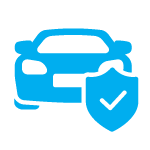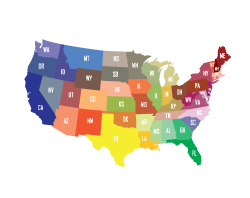DIVISION 11.5. Sentencing for Driving While Under the Influence
CHAPTER 2. Court Penalties
ARTICLE 5. Additional Penalties and Sanctions
23575. (a) The court shall require a person convicted of a violation of Section 14601.2 to install a functioning, certified ignition interlock device on any vehicle that the person operates and prohibit the person from operating a motor vehicle unless the vehicle is equipped with a functioning, certified ignition interlock device. The term of the restriction shall be determined by the court for a period not to exceed three years from the date of conviction. The court shall notify the Department of Motor Vehicles, as specified in subdivision (a) of Section 1803, of the terms of the restrictions in accordance with subdivision (a) of Section 1804. The Department of Motor Vehicles shall place the restriction in the person’s records in the Department of Motor Vehicles.
(b) The court shall include on the abstract of conviction or violation submitted to the Department of Motor Vehicles under Section 1803 or 1816 the requirement and term for the use of a functioning, certified ignition interlock device. The records of the department shall reflect mandatory use of the device for the term ordered by the court.
(c) The court shall advise the person that installation of an ignition interlock device on a vehicle does not allow the person to drive without a valid driver’s license.
(d) A person whose driving privilege is restricted by the court pursuant to this section shall arrange for each vehicle with a functioning, certified ignition interlock device to be serviced by the installer at least once every 60 days in order for the installer to recalibrate and monitor the operation of the device. The installer shall notify the court if the device is removed or indicates that the person has attempted to remove, bypass, or tamper with the device, or if the person fails three or more times to comply with any requirement for the maintenance or calibration of the ignition interlock device. There is no obligation for the installer to notify the court if the person has complied with all of the requirements of this article.
(e) The court shall monitor the installation and maintenance of a functioning, certified ignition interlock device restriction ordered pursuant to subdivision (a) or (i). If a person fails to comply with the court order, the court shall give notice of the fact to the department pursuant to Section 40509.1.
(f) Nothing in this section permits a person to drive without a valid driver’s license.
(g) Pursuant to this section, an out-of-state resident who otherwise would qualify for an ignition interlock device restricted license in California shall be prohibited from operating a motor vehicle in California unless that vehicle is equipped with a functioning, certified ignition interlock device. An ignition interlock device is not required to be installed on any vehicle owned by the defendant that is not driven in California.
(h) If a medical problem does not permit a person to breathe with sufficient strength to activate the device, that person shall only have the suspension option.
(i) This section does not restrict a court from requiring installation of a functioning, certified ignition interlock device and prohibiting operation of a motor vehicle unless that vehicle is equipped with a functioning, certified ignition interlock device for a person to whom subdivision (a) does not apply. The term of the restriction shall be determined by the court for a period not to exceed three years from the date of conviction. The court shall notify the Department of Motor Vehicles, as specified in subdivision (a) of Section 1803, of the terms of the restrictions in accordance with subdivision (a) of Section 1804. The Department of Motor Vehicles shall place the restriction in the person’s records in the Department of Motor Vehicles.
(j) For the purposes of this section, “vehicle” does not include a motorcycle until the state certifies an ignition interlock device that can be installed on a motorcycle. Any person subject to an ignition interlock device restriction shall not operate a motorcycle for the duration of the ignition interlock device restriction period.
(k) (1) For the purposes of this section, “owned” means solely owned or owned in conjunction with another person or legal entity.
(2) For purposes of this section, “operates” includes operating a vehicle that is not owned by the person subject to this section.
(l) For the purposes of this section, “bypass” means either of the following:
(1) Failure to take any random retest.
(2) Failure to pass any random retest with a breath alcohol concentration not exceeding 0.03 percent breath alcohol concentration.
(m) The department shall adopt regulations specifying the intervals between random retests.
(n) For purposes of this section, “random retest” means a breath test performed by the driver upon a certified ignition interlock device at random intervals after the initial engine startup breath test and while the vehicle’s motor is running.
(o) This section shall become operative on January 1, 2019.
(p) This section shall remain in effect only until January 1, 2026, and as of that date is repealed, unless a later enacted statute, that is enacted before January 1, 2026, deletes or extends that date.
(Amended (as added by Stats. 2016, Ch. 783, Sec. 33) by Stats. 2017, Ch. 485, Sec. 26. (SB 611) Effective January 1, 2018. Section operative January 1, 2019, by its own provisions. Repealed as of January 1, 2026, by its own provisions. See later operative version, as amended by Sec. 27 of Stats. 2017, Ch. 485.)
23575.1. The department may undertake a study and report its findings of that study to the Legislature on or before January 1, 2013, regarding the overall effectiveness of the use of ignition interlock devices (IID) to reduce the recidivism rate of first-time violators of Section 23152 or 23153. If the department exercises this authority, the study shall focus on those drivers who actually have an IID installed in their vehicles rather than on those who are subject to a judicial order to have an IID installed.
(Added by Stats. 2008, Ch. 392, Sec. 2. Effective January 1, 2009.)
23757.3 (a) In addition to any other requirement imposed by law, a court shall notify a person convicted of a violation listed in subdivision (h) that he or she is required to install a functioning, certified ignition interlock device on any vehicle that the person operates and that he or she is prohibited from operating a motor vehicle unless that vehicle is equipped with a functioning, certified ignition interlock device in accordance with this section.
(b) The Department of Motor Vehicles, upon receipt of the court’s abstract of conviction for a violation listed in subdivision (h), shall inform the convicted person of the requirements of this section, including the term for which the person is required to have a certified ignition interlock device installed. The records of the department shall reflect the mandatory use of the device for the term required and the time when the device is required to be installed by this code.
(c) The department shall advise the person that installation of a functioning, certified ignition interlock device on a vehicle does not allow the person to drive without a valid driver’s license.
(d) (1) A person who is notified by the department pursuant to subdivision (b) shall do all of the following:
(A) Arrange for each vehicle operated by the person to be equipped with a functioning, certified ignition interlock device by a certified ignition interlock device provider under Section 13386.
(B) Provide to the department proof of installation by submitting the “Verification of Installation” form described in paragraph (2) of subdivision (g) of Section 13386.
(C) Pay a fee, determined by the department, that is sufficient to cover the costs of administration of this section.
(2) A person who is notified by the department pursuant to subdivision (b), is exempt from the requirements of this subdivision until the time he or she purchases or has access to a vehicle if, within 30 days of the notification, the person certifies to the department all of the following:
(A) The person does not own a vehicle.
(B) The person does not have access to a vehicle at his or her residence.
(C) The person no longer has access to the vehicle he or she was driving at the time he or she was arrested for a violation that subsequently resulted in a conviction for a violation listed in subdivision (h).
(D) The person acknowledges that he or she is only allowed to drive a vehicle that is equipped with a functioning, certified ignition interlock device.
(E) The person acknowledges that he or she is required to have a valid driver’s license before he or she can drive.
(F) The person acknowledges that he or she is subject to the requirements of this section when he or she purchases or has access to a vehicle.
(e) In addition to any other restrictions the department places on the driver’s license record of the convicted person when the person is issued a restricted driver’s license pursuant to Section 13352 or 13352.4, the department shall place a restriction on the driver’s license record of the person that states the driver is restricted to driving only vehicles equipped with a functioning, certified ignition interlock device for the applicable term.
(f) (1) A person who is notified by the department pursuant to subdivision (b) shall arrange for each vehicle with a functioning, certified ignition interlock device to be serviced by the installer at least once every 60 days in order for the installer to recalibrate and monitor the operation of the device.
(2) The installer shall notify the department if the device is removed or indicates that the person has attempted to remove, bypass, or tamper with the device, or if the person fails three or more times to comply with any requirement for the maintenance or calibration of the ignition interlock device.
(g) The department shall monitor the installation and maintenance of the ignition interlock device installed pursuant to subdivision (d).
(h) A person is required to install a functioning, certified ignition interlock device pursuant to this section for the applicable term, as follows:
(1) A person convicted of a violation of subdivision (a), (b), (d), (e), or (g) of Section 23152 shall be required to do the following, as applicable:
(A) Upon a conviction with no priors, punishable under Section 23536, only one of the following may occur:
(i) The court may order installation of a functioning, certified ignition interlock device on any vehicle that the person operates and prohibit that person from operating a motor vehicle unless that vehicle is equipped with a functioning, certified ignition interlock device. If the court orders the ignition interlock device restriction, the term shall be determined by the court for a period not to exceed six months from the date of conviction. The court shall notify the department of the conviction as specified in subdivision (a) of Section 1803 or Section 1816, and shall specify the terms of the ignition interlock device restriction in accordance with subdivision (a) of Section 1804. The department shall place the restriction on the driver’s license record of the person that states the driver is restricted to driving only vehicles equipped with a functioning, certified ignition interlock device for the applicable term.
(ii) The person may apply to the department for a restriction of the driving privilege under Section 13352.4.
(iii) The person may apply to the department for a restriction of the driving privilege under paragraph (1) of subdivision (a) of Section 13352 or subdivision (c) of Section 13352.1.
(B) Upon a conviction with one prior, punishable under Section 23540, the person shall install a functioning, certified ignition interlock device in the vehicle, as ordered by the court, that is operated by that person for a mandatory term of 12 months.
(C) Upon a conviction with two priors, punishable under Section 23546, the person shall install a functioning, certified ignition interlock device in the vehicle, as ordered by the court, that is operated by that person for a mandatory term of 24 months.
(D) Upon a conviction with three or more priors punishable under Section 23550, or a conviction punishable under Section 23550.5, the person shall install a functioning, certified ignition interlock device in the vehicle, as ordered by the court, that is operated by that person for a mandatory term of 36 months.
(2) A person convicted of a violation of subdivision (a), (b), (d), (e), or (g) of Section 23153 shall install a functioning, certified ignition interlock device, as follows:
(A) Upon a conviction with no priors, punishable under Section 23554, the person shall install a functioning, certified ignition interlock device in the vehicle, as ordered by the court, that is operated by that person for a mandatory term of 12 months.
(B) Upon a conviction with one prior, punishable under Section 23560, the person shall install a functioning, certified ignition interlock device in the vehicle, as ordered by the court, that is operated by that person for a mandatory term of 24 months.
(C) Upon a conviction with two priors, punishable under Section 23550 or 23566, the person shall install a functioning, certified ignition interlock device in the vehicle, as ordered by the court, that is operated by that person for a mandatory term of 36 months.
(D) Upon a conviction with one prior punishable under Section 23550.5, the person shall install a functioning, certified ignition interlock device in the vehicle, as ordered by the court, that is operated by that person for a mandatory term of 48 months.
(3) For the purposes of paragraphs (1) and (2), “prior” means a conviction for a separate violation of Section 23103, as specified in Section 23103.5, or Section 23152 or 23153, subdivision (a) or (b) of Section 191.5 of, or subdivision (a) of Section 192.5 of, the Penal Code, or subdivision (b), (c), (d), (e), or (f) of Section 655 of the Harbors and Navigation Code, that occurred within 10 years of the current violation.
(4) The terms prescribed in this subdivision shall begin once a person has complied with subparagraph (B) of paragraph (1) of subdivision (d) and either upon the reinstatement of the privilege to drive pursuant to Section 13352 or the issuance of a restricted driver’s license pursuant to Section 13352. A person shall receive credit for any period in which he or she had a restricted driver’s license issued pursuant to Section 13353.6 or 13353.75.
(i) Subdivisions (g), (h), (j), and (k) of Section 23575 apply to this section.
(j) If a person fails to comply with any of the requirements regarding ignition interlock devices, the period in which the person was not in compliance shall not be credited towards the mandatory term for which the ignition interlock device is required to be installed.
(k) (1) Every manufacturer and manufacturer’s agent certified by the department to provide ignition interlock devices, under Section 13386, shall adopt the following fee schedule that provides for the payment of the costs of the certified ignition interlock device by offenders subject to this chapter in amounts commensurate with that person’s income relative to the federal poverty level, as defined in Section 127400 of the Health and Safety Code:
(A) A person with an income at 100 percent of the federal poverty level or below and who provides income verification pursuant to paragraph (2) is responsible for 10 percent of the cost of the manufacturer’s standard ignition interlock device program costs, and any additional costs accrued by the person for noncompliance with program requirements.
(B) A person with an income at 101 to 200 percent of the federal poverty level and who provides income verification pursuant to paragraph (2) is responsible for 25 percent of the cost of the manufacturer’s standard ignition interlock device program costs, and any additional costs accrued by the person for noncompliance with program requirements.
(C) A person with an income at 201 to 300 percent of the federal poverty level and who provides income verification pursuant to paragraph (2) is responsible for 50 percent of the cost of the manufacturer’s standard ignition interlock device program costs, and any additional costs accrued by the person for noncompliance with program requirements.
(D) A person who is receiving CalFresh benefits and who provides proof of those benefits to the manufacturer or manufacturer’s agent or authorized installer is responsible for 50 percent of the cost of the manufacturer’s standard ignition interlock device program costs, and any additional costs accrued by the person for noncompliance with program requirements.
(E) A person with an income at 301 to 400 percent of the federal poverty level and who provides income verification pursuant to paragraph (2) is responsible for 90 percent of the cost of the manufacturer’s standard ignition interlock device program costs, and any additional costs accrued by the person for noncompliance with program requirements.
(F) All other offenders are responsible for 100 percent of the cost of the ignition interlock device.
(G) The manufacturer is responsible for the percentage of costs that the offender is not responsible for pursuant to subparagraphs (A) to (E), inclusive.
(2) The ignition interlock device provider shall verify the offender’s income to determine the cost of the ignition interlock device pursuant to this subdivision by verifying one of the following documents from the offender:
(A) The previous year’s federal income tax return.
(B) The previous three months of weekly or monthly income statements.
(C) Employment Development Department verification of unemployment benefits.
(l) The Department of Consumer Affairs may impose a civil assessment not to exceed one thousand dollars ($1,000) upon a manufacturer or manufacturer’s agent certified to provide ignition interlock devices who fails to inform an offender subject to this chapter of the provisions of subdivision (k), or who fails to comply with the provisions of subdivision (k).
(m) This section does not permit a person to drive without a valid driver’s license.
(n) The requirements of this section are in addition to any other requirements of law.
(o) For the purposes of this section, the following definitions apply:
(1) “Bypass” means either of the following:
(A) Failure to take any random retest.
(B) Failure to pass a random retest with a breath alcohol concentration not exceeding 0.03 percent, by weight of alcohol, in the person’s blood.
(2) “Operates” includes operating a vehicle that is not owned by the person subject to this section.
(3) “Owned” means solely owned or owned in conjunction with another person or legal entity.
(4) “Random retest” means a breath test performed by the driver upon a certified ignition interlock device at random intervals after the initial engine startup breath test and while the vehicle’s motor is running.
(5) “Vehicle” does not include a motorcycle until the state certifies an ignition interlock device that can be installed on a motorcycle. A person subject to an ignition interlock device restriction shall not operate a motorcycle for the duration of the ignition interlock device restriction period.
(p) The requirements of this section shall apply only to a person who is convicted for a violation of Section 23152 or 23153 that occurred on or after January 1, 2019.
(q) This section shall become operative on January 1, 2019.
(r) This section shall remain in effect only until January 1, 2026, and as of that date is repealed, unless a later enacted statute, that is enacted before January 1, 2026, deletes or extends that date.
(Amended by Stats. 2017, Ch. 485, Sec. 28. (SB 611) Effective January 1, 2018. Section operative January 1, 2019, by its own provisions. Repealed as of January 1, 2026, by its own provisions.)
23575.5 (a) On or before March 1, 2024, the Department of Motor Vehicles shall report data to the Transportation Agency regarding the implementation and efficacy of the program enacted by the act that added this section.
(b) The data described in subdivision (a) shall, at a minimum, include all of the following:
(1) The number of individuals who were required to have a functioning, certified ignition interlock device installed as a result of the program who killed or injured anyone in an accident while he or she was operating a vehicle under the influence of alcohol.
(2) The number of individuals who were required to have a functioning, certified ignition interlock device installed as a result of the program who were convicted of an alcohol-related violation of Section 23103, as specified in Section 23103.5, or Section 23140, 23152, or 23153, or Section 191.5 or subdivision (a) of Section 192.5 of the Penal Code during the term in which the person was required to have the ignition interlock device installed.
(3) The number of injuries and deaths resulting from alcohol-related motor vehicle accidents between January 1, 2019, and January 1, 2024, inclusive, and during periods of similar duration prior to the implementation of the program.
(4) The number of individuals who have been convicted more than one time for driving under the influence of alcohol between January 1, 2019, and January 1, 2024, inclusive, and periods of similar duration prior to the implementation of the program.
(5) Any other information requested by the Transportation Agency to assess the effectiveness of the statewide ignition interlock device requirement in reducing recidivism for driving-under-the-influence violations.
(c) The Transportation Agency may contract with educational institutions to obtain and analyze the data required by this section.
(d) The Transportation Agency shall assess the program based on the data provided pursuant to subdivision (b) and shall report to the Legislature on the outcomes of the program no later than January 1, 2025.
(e) The report described in subdivision (a) shall be submitted in compliance with Section 9795 of the Government Code.
(f) (1) This section shall become operative on January 1, 2019.
(2) This section is repealed as of January 1, 2029, unless a later enacted statute, that becomes operative on or before January 1, 2029, deletes or extends the dates on which it becomes inoperative and is repealed.
(Added by Stats. 2016, Ch. 783, Sec. 36. (SB 1046) Effective January 1, 2017. Section operative January 1, 2019, by its own provisions. Repealed as of January 1, 2029, by its own provisions.)
23576. (a) Notwithstanding Sections 13352, 13352.1, 13353.6, 13353.75, 23573, 23575, 23575.3, and 23700, if a person is required to operate a motor vehicle in the course and scope of his or her employment and if the vehicle is owned by the employer, the person may operate that vehicle without installation of a functioning, certified approved ignition interlock device if the employer has been notified by the person that the person’s driving privilege has been restricted pursuant to Section 13352, 13352.1, 13353.6, 13353.75, 23573, 23575, 23575.3, or 23700 and if the person has proof of that notification in his or her possession, or if the notice, or a facsimile copy thereof, is with the vehicle.
(b) A motor vehicle owned by a business entity that is all or partly owned or controlled by a person otherwise subject to Section 13352, 13352.1, 13353.6, 13353.75, 23573, 23575, 23575.3, or 23700, is not a motor vehicle owned by the employer subject to the exemption in subdivision (a).
(c) This section shall become operative on January 1, 2019.
(d) This section shall remain in effect only until January 1, 2026, and as of that date is repealed, unless a later enacted statute, that is enacted before January 1, 2026, deletes or extends that date.
(Amended (as added by Stats. 2016, Ch. 783, Sec. 38) by Stats. 2017, Ch. 485, Sec. 29. (SB 611) Effective January 1, 2018. Section operative January 1, 2019, by its own provisions. Repealed as of January 1, 2026, by its own provisions. See later operative version added by Sec. 39 of Stats. 2016, Ch. 783.)
23576. (a) Notwithstanding Sections 23575 and 23700, if a person is required to operate a motor vehicle in the course and scope of his or her employment and if the vehicle is owned by the employer, the person may operate that vehicle without installation of a functioning, certified ignition interlock device if the employer has been notified by the person that the person’s driving privilege has been restricted pursuant to Section 23575 or 23700 and if the person has proof of that notification in his or her possession, or if the notice, or a facsimile copy thereof, is with the vehicle.
(b) A motor vehicle owned by a business entity that is all or partly owned or controlled by a person otherwise subject to Section 23575 or 23700 is not a motor vehicle owned by the employer subject to the exemption in subdivision (a).
(c) This section shall become operative January 1, 2026.
(Repealed (in Sec. 38) and added by Stats. 2016, Ch. 783, Sec. 39. (SB 1046) Effective January 1, 2017. Section operative January 1, 2026, by its own provisions.)
23577. (a) If a person is convicted of a violation of Section 23152 or 23153, and at the time of the arrest leading to that conviction that person willfully refused a peace officer’s request to submit to, or willfully failed to complete, the breath or urine tests pursuant to Section 23612, the court shall impose the following penalties:
(1) If the person is convicted of a first violation of Section 23152, notwithstanding any other provision of subdivision (a) of Section 23538, the terms and conditions of probation shall include the conditions in paragraph (1) of subdivision (a) of Section 23538.
(2) If the person is convicted of a first violation of Section 23153, the punishment shall be enhanced by an imprisonment of 48 continuous hours in the county jail, whether or not probation is granted and no part of which may be stayed, unless the person is sentenced to, and incarcerated in, the state prison and the execution of that sentence is not stayed.
(3) If the person is convicted of a second violation of Section 23152, punishable under Section 23540, or a second violation of Section 23153, punishable under Section 23560, the punishment shall be enhanced by an imprisonment of 96 hours in the county jail, whether or not probation is granted and no part of which may be stayed, unless the person is sentenced to, and incarcerated in, the state prison and execution of that sentence is not stayed.
(4) If the person is convicted of a third violation of Section 23152, punishable under Section 23546, the punishment shall be enhanced by an imprisonment of 10 days in the county jail, whether or not probation is granted and no part of which may be stayed.
(5) If the person is convicted of a fourth or subsequent violation of Section 23152, punishable under Section 23550 or 23550.5, the punishment shall be enhanced by imprisonment of 18 days in the county jail, whether or not probation is granted and no part of which may be stayed.
(b) The willful refusal or failure to complete the breath or urine test required pursuant to Section 23612 shall be pled and proven.
(c) The penalties in this section do not apply to a person who refused to submit to or complete a blood test pursuant to Section 23612. This section does not prohibit imposition of administrative actions involving driving privileges.
(Amended by Stats. 2018, Ch. 177, Sec. 1. (AB 2717) Effective January 1, 2019.)
23578. In addition to any other provision of this code, if a person is convicted of a violation of Section 23152 or 23153, the court shall consider a concentration of alcohol in the person’s blood of 0.15 percent or more, by weight, or the refusal of the person to take a breath or urine test, as a special factor that may justify enhancing the penalties in sentencing, in determining whether to grant probation, and, if probation is granted, in determining additional or enhanced terms and conditions of probation.
(Amended by Stats. 2018, Ch. 177, Sec. 2. (AB 2717) Effective January 1, 2019.)
23580. (a) If any person is convicted of a violation of Section 23152 or 23153 and the offense was a second or subsequent offense punishable under Section 23540, 23546, 23550, 23550.5, 23560, or 23566, the court shall require that any term of imprisonment that is imposed include at least one period of not less than 48 consecutive hours of imprisonment or, in the alternative and notwithstanding Section 4024.2 of the Penal Code, that the person serve not less than 10 days of community service.
(b) Notwithstanding any other provision of law, except Section 2900.5 of the Penal Code, unless the court expressly finds in the circumstances that the punishment inflicted would be cruel or unusual punishment prohibited by Section 17 of Article I of the California Constitution, no court or person to whom a person is remanded for execution of sentence shall release, or permit the release of, a person from the requirements of subdivision (a), including, but not limited to, any work-release program, weekend service of sentence program, diversion or treatment program, or otherwise.
(c) For the purposes of this section, “imprisonment” means confinement in a jail, in a minimum security facility, or in an inpatient rehabilitation facility, as provided in Part 1309 (commencing with Section 1309.1) of Title 23 of the Code of Federal Regulations.
(Amended by Stats. 2002, Ch. 664, Sec. 223. Effective January 1, 2003.)
23582. (a) Any person who drives a vehicle 30 or more miles per hour over the maximum, prima facie, or posted speed limit on a freeway, or 20 or more miles per hour over the maximum, prima facie, or posted speed limit on any other street or highway, and in a manner prohibited by Section 23103 during the commission of a violation of Section 23152 or 23153 shall, in addition to the punishment prescribed for that person upon conviction of a violation of Section 23152 or 23153, be punished by an additional and consecutive term of 60 days in the county jail.
(b) If the court grants probation or suspends the execution of sentence, it shall require as a condition of probation or suspension that the defendant serve 60 days in the county jail, in addition and consecutive to any other sentence prescribed by this chapter.
(c) On a first conviction under this section, the court shall order the driver to participate in, and successfully complete, an alcohol or drug education and counseling program, or both an alcohol and a drug education and counseling program. Except in unusual cases where the interests of justice would be served, a finding making this section applicable to a defendant shall not be stricken pursuant to Section 1385 of the Penal Code or any other provision of law. If the court decides not to impose the additional and consecutive term, it shall specify on the court record the reasons for that order.
(d) The additional term provided in this section shall not be imposed unless the facts of driving in a manner prohibited by Section 23103 and driving the vehicle 30 or more miles per hour over the maximum, prima facie, or posted speed limit on a freeway, or 20 or more miles per hour over the maximum, prima facie, or posted speed limit on any other street or highway, are charged in the accusatory pleading and admitted or found to be true by the trier of fact. A finding of driving in that manner shall be based on facts in addition to the fact that the defendant was driving while under the influence of alcohol, any drug, or both, or with a specified percentage of alcohol in the blood.
(Added by Stats. 1998, Ch. 118, Sec. 84. Effective January 1, 1999. Section operative July 1, 1999, pursuant to Section 23675.)







